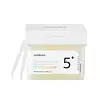What's inside
What's inside
 Key Ingredients
Key Ingredients

 Benefits
Benefits

 Concerns
Concerns

 Ingredients Side-by-side
Ingredients Side-by-side

Salicylic Acid 2%
MaskingWater
Skin ConditioningPentylene Glycol
Skin ConditioningPropanediol
SolventHamamelis Virginiana Water
AstringentAzelaic Acid
BufferingGlycolic Acid
BufferingPolylysine
Urea
BufferingYeast Amino Acids
HumectantTrehalose
HumectantInositol
HumectantTaurine
BufferingBetaine
HumectantAllantoin
Skin ConditioningGlycerin
HumectantLeuconostoc/Radish Root Ferment Filtrate
AntimicrobialTetrasodium Glutamate Diacetate
Sodium Hydroxide
BufferingBenzoic Acid
MaskingSalicylic Acid 2%, Water, Pentylene Glycol, Propanediol, Hamamelis Virginiana Water, Azelaic Acid, Glycolic Acid, Polylysine, Urea, Yeast Amino Acids, Trehalose, Inositol, Taurine, Betaine, Allantoin, Glycerin, Leuconostoc/Radish Root Ferment Filtrate, Tetrasodium Glutamate Diacetate, Sodium Hydroxide, Benzoic Acid
Water
Skin ConditioningNiacinamide
SmoothingDipropylene Glycol
HumectantGlycerin
HumectantPropanediol
SolventButylene Glycol
HumectantHydroxyethyl Urea
HumectantDiethoxyethyl Succinate
SolventHydroxyacetophenone
AntioxidantCaprylyl Glycol
EmollientPolyglyceryl-10 Laurate
Skin ConditioningBetaine
HumectantPanthenol
Skin ConditioningEthylhexylglycerin
Skin ConditioningGluconolactone
Skin ConditioningSodium Polyacrylate
AbsorbentAmmonium Acryloyldimethyltaurate/Vp Copolymer
Sodium Citrate
BufferingCitric Acid
BufferingMaltodextrin
Absorbent1,2-Hexanediol
Skin ConditioningGardenia Florida Fruit Extract
Skin ConditioningDipotassium Glycyrrhizate
HumectantSodium Hyaluronate
HumectantAscorbic Acid
AntioxidantPantolactone
HumectantTocopherol
AntioxidantCapryloyl Salicylic Acid
ExfoliatingTranexamic Acid
AstringentTremella Fuciformis Extract
HumectantCaprylic/Capric Triglyceride
MaskingAscorbyl Glucoside
AntioxidantUbiquinone
AntioxidantHydrogenated Lecithin
EmulsifyingMagnesium Chloride
Alcohol
AntimicrobialGlutathione
Polysorbate 80
EmulsifyingCalcium Gluconate
HumectantPyridoxine Hcl
Skin ConditioningBHT
AntioxidantYeast Extract
Skin ConditioningCyanocobalamin
Skin ConditioningDisodium EDTA
Water, Niacinamide, Dipropylene Glycol, Glycerin, Propanediol, Butylene Glycol, Hydroxyethyl Urea, Diethoxyethyl Succinate, Hydroxyacetophenone, Caprylyl Glycol, Polyglyceryl-10 Laurate, Betaine, Panthenol, Ethylhexylglycerin, Gluconolactone, Sodium Polyacrylate, Ammonium Acryloyldimethyltaurate/Vp Copolymer, Sodium Citrate, Citric Acid, Maltodextrin, 1,2-Hexanediol, Gardenia Florida Fruit Extract, Dipotassium Glycyrrhizate, Sodium Hyaluronate, Ascorbic Acid, Pantolactone, Tocopherol, Capryloyl Salicylic Acid, Tranexamic Acid, Tremella Fuciformis Extract, Caprylic/Capric Triglyceride, Ascorbyl Glucoside, Ubiquinone, Hydrogenated Lecithin, Magnesium Chloride, Alcohol, Glutathione, Polysorbate 80, Calcium Gluconate, Pyridoxine Hcl, BHT, Yeast Extract, Cyanocobalamin, Disodium EDTA
 Reviews
Reviews

Ingredients Explained
These ingredients are found in both products.
Ingredients higher up in an ingredient list are typically present in a larger amount.
Betaine is a common humectant (a substance that promotes retention of moisture). It's known to be gentle on the skin and can help balance hydration.
This ingredient is best for improving hydration and soothing irritated skin. Studies also show it helps even out skin tone.
Fun fact: Betaine is naturally created in the skin and body. The kind found within cosmetic products can be either plant-derived or synthetic.
Another name for betaine is trimethylglycine.
Learn more about BetaineGlycerin is already naturally found in your skin. It helps moisturize and protect your skin.
A study from 2016 found glycerin to be more effective as a humectant than AHAs and hyaluronic acid.
As a humectant, it helps the skin stay hydrated by pulling moisture to your skin. The low molecular weight of glycerin allows it to pull moisture into the deeper layers of your skin.
Hydrated skin improves your skin barrier; Your skin barrier helps protect against irritants and bacteria.
Glycerin has also been found to have antimicrobial and antiviral properties. Due to these properties, glycerin is often used in wound and burn treatments.
In cosmetics, glycerin is usually derived from plants such as soybean or palm. However, it can also be sourced from animals, such as tallow or animal fat.
This ingredient is organic, colorless, odorless, and non-toxic.
Glycerin is the name for this ingredient in American English. British English uses Glycerol/Glycerine.
Learn more about GlycerinPropanediol is an all-star ingredient. It softens, hydrates, and smooths the skin.
It’s often used to:
Propanediol is not likely to cause sensitivity and considered safe to use. It is derived from corn or petroleum with a clear color and no scent.
Learn more about PropanediolWater. It's the most common cosmetic ingredient of all. You'll usually see it at the top of ingredient lists, meaning that it makes up the largest part of the product.
So why is it so popular? Water most often acts as a solvent - this means that it helps dissolve other ingredients into the formulation.
You'll also recognize water as that liquid we all need to stay alive. If you see this, drink a glass of water. Stay hydrated!
Learn more about Water